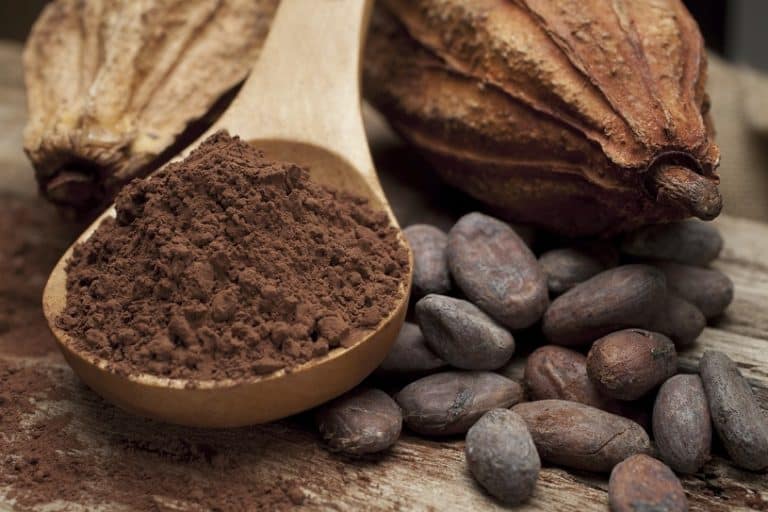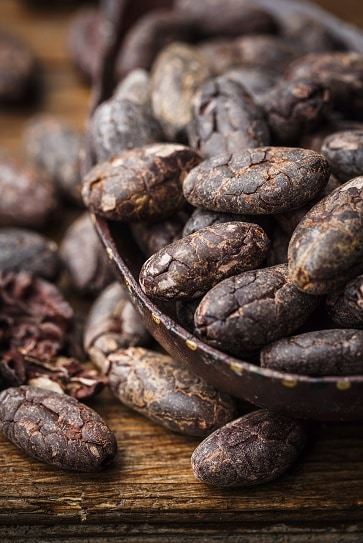 Dark chocolate is a food which offers up numerous opportunities for acne patients. Firstly, it’s amazing for acne itself, supplying antioxidants and phyotnutrients which your gut bacteria convert to anti-inflammatory by-products.
Dark chocolate is a food which offers up numerous opportunities for acne patients. Firstly, it’s amazing for acne itself, supplying antioxidants and phyotnutrients which your gut bacteria convert to anti-inflammatory by-products.
Secondly, dark chocolate tastes great enough to banish tempting thoughts of pizzas, donuts and cake from your mind. Dark chocolate is an acne-friendly indulgence which you never have to resist.
Finally, dark chocolate is able to boost your mood and lower stress, with its magnesium and anandamide.
But what about pesticides? All chocolate begins life as a cocoa bean crop regardless of what it becomes. If most dark chocolate, whether from a supermarket or a tiny shop in a Belgian alleyway, was drenched with toxic chemicals, every one of those benefits would be beyond our grasp unless we spent valuable money on the organic version.
Which is why today, we will analyse the question in detail. Do cocoa beans fall into the category of apples, which are drenched with pesticides, or pineapples, which contain little?
Why cocoa farmers love pesticides
The answer is that the organic chocolate situation is almost identical to organic coffee. Both are blasted with huge amounts of pesticides, but may just scrape into safe territory because of the roasting process which destroys the chemicals.
Cocoa’s first similarity to coffee is the massive amount of pests it faces. Insects and humans share a common love of this plant and cocoa farmers must duel with beetles, moths, worms, stemborers, termites, fungi, and viruses.
Consequently, organic chocolate makes up a tiny fraction of the overall market. It’s actually lower than coffee, at 0.5% vs 8.5%, with the Dominican Republic enjoying a 70% market stranglehold and 20% coming from Peru, Mexico and Ecuador.
70% of the world’s cocoa is grown in West Africa and 21% in Ghana. The cocoa industry is still dominated by small scale peasant farmers, creating a perception that cocoa farmers are too poor to afford pesticides, but that isn’t the case.
Firstly, African governments often subsidise pesticides, or even create agricultural programs to distribute them. Sometimes African governments even send out crack squads to spray pesticides themselves, with the farmers only providing vehicle fuel. Like any government, they’re determined to see their economy succeed and they have to support their key industries.
Read Annihilate Your Acne – get the ultimate diet and clear your acne permanently!
Secondly, pesticides are a worthwhile investment for cocoa farmers themselves, no matter how poor they are. Pesticides undeniably boost cocoa yields significantly; the only economic reason to reject them is to exploit the organic market.
Because they’re so effective, overall pesticide usage in developing countries is increasing sharply. For example, from 2004 to 2009, Nigeria’s fungicide usage increased by nearly 70% and there’s no hint of a slowdown. Awareness of the dangers is increasing, but there’s two sides to the coin:
GOOD: several of the deadliest cocoa pesticides have been banned. One example is DDT, which is “probably carcinogenic” and disrupts hormonal health. DDT was outlawed because of its rapid accumulation in soils and drinking water.
BAD: many poor farmers ignore those restrictions and purchase banned pesticides on the black market. In Cameroon, it was once estimated that 51% of pesticides are bought by farmers illegally. Rural and isolated farmers may not realise that the chemicals are banned.
Another factor is that poor, uneducated African farmers misuse the pesticides by applying too much. Sometimes as little as 10% of farmers have formal agrochemical training.
Like with coffee, the nature of the industry makes pesticides open for business, because most people eat chocolate as a sweet treat, an indulgence. Therefore they don’t care about the pesticides whenever they feel like eating a bar. Like with coffee, a few people eat dark chocolate because they read a newspaper article about its heart protecting benefits, but overall, conventional produce reigns supreme.
One advantage is that the EU has imposed maximum residue limits for cocoa bean pesticides, but there’s debate over whether those limits are too lax. Finally, the huge variety of pests means that farmers have to apply a huge variety of chemicals.
The cocoa bean situation in Ghana
If you want to understand how much the average cocoa bean is blasted with pesticides, you just need to look at the world cocoa capital, Ghana.
This West African land began exporting cocoa as early as 1891, and from 1911 to 1970, Ghana held its current position as the number one cocoa bean exporter. This changed when the Ivory Coast took over in 1977 and Ghana fell into military rule, as the government suppressed the usage of insecticides.
For decades, mirids and other insects attacked cocoa beans relentlessly. The government tried to compensate by deforesting vast areas of land and creating new cocoa farms but Ghana slowly fell to the world number 12 cocoa exporter in the mid 1980s. It was estimated that mirids alone crippled cocoa crops by 25-35% per year. Raging bushfires and general economic depression also contributed.
Then in 2000, the military government was overthrown, and to restore the economy and formerly prestigious industry, the new government initiated a vast scheme of pesticide and agrochemical distribution.
They created the Cocoa Diseases and Pests Control Programme, or CODAPEC. This national body trained farmers in the proper usage of agrochemicals, including the different types, how to minimise the dangers, and environmental safety issues. CODAPEC trained the farmers using workshops, radio broadcasts and town meetings.
Recommended – the top 6 vitamins and minerals for acne-free skin
Cocoa production increased sharply again, so that by 2005, cocoa was second only to gold (Ghana was originally called the gold coast) in the economy. 16.5% of Ghana’s agricultural product was cocoa and 65% of agricultural workers were connected to the industry. To keep the economic success train rolling, CODAPEC made sure that pesticides were distributed to the most far flung jungles.
Ghana returned to its rightful place at the the head of cocoa production and pesticides made it all possible.
The second part of this pesticide story is the application. According to various studies and reports…
ONE – 13.3% of farmers in Ghana’s Volta region used pesticides which are banned by Ghana’s cocoa board (study).
TWO – 59.8% of farmers dispose of empty pesticide containers and 79.2% dispose of pesticide spray water by throwing them on their farms, resulting in unnecessary chemical contamination of soil (study).
THREE – 62.5 % of cocoa bean samples contain p,p’-DDT, a metabolite of the banned pesticide DDT, proving that DDT persists in Ghanaian soil years after being banned (study).
FOUR – in the same 2016 study, 56.3% of cocoa bean samples contained the once dominant pesticide lindane which is now banned due to being a cancerous neurotoxin. Lindane was once detected in chocolate bars themselves back in the 1990s, in a widely publicised study that led to much fear. Levels of lindane were also consistent around different sites in Ghana.
FIVE – surveys across many studies find that a rural few farmers hold out, but the vast majority make use of pesticides and insecticides.
Like anywhere, some farmers in 2019 are seasoned professionals while others are bumbling amateurs. There’s probably other factors that we don’t know about too: corrupt governmental officials, cocoa beans of wildly different quality being pooled together, new pesticides which the EU can’t detect yet, and so on.
Despite being king of the cocoa castle, the evolution of pesticides in Ghana represents the rest of cocoa-growing countries well.
The anti-cocoa alliance
 Why exactly does cocoa have to be sprayed with so many chemicals? Because in total, over 1500 pests worldwide are known to feed on the cocoa tree.
Why exactly does cocoa have to be sprayed with so many chemicals? Because in total, over 1500 pests worldwide are known to feed on the cocoa tree.
Only 2% cause serious economic damage, but wherever cocoa beans are introduced, a new insect consistently pops up to feast on them. Some of cocoa farmers’ biggest foes are…
Mirids – nothing makes a mirid happier than seeing a freshly planted row of cocoa trees. These insects were first spotted in Ghana back in 1908 and a huge antimirid campaign in the early 1960s led Nigeria to become a big player in the cocoa market.
The top 7 topical treatments for clearing acne naturally
The main species is the cocoa capsid, or Distantiella theobroma. Mirids attack most parts of the cocoa crop, the stems, the branches, the pods. They pierce the tree’s defences and cause cells to die. Female mirids can lay 60 eggs at once within the cocoa tree’s bark.
Mirids particularly love cocoa trees planted in the sun since they produce more fresh shoots and pods, and modern farming makes such trees easily available. Ignore mirids and your cocoa bean harvest can fall by 75% after three years, and that’s why insecticides are so common, with imidacloprid being the most applied.
Phytophthora pod rot – the main fungal infection which threatens cocoa beans nationwide. This disease causes cocoa pods to turn brown and reddish black and die, with immature pods in shells never reaching full maturity. The infection is also known as black pod or akate. It affects the entire world but particularly West Africa.
Black pod rot can attack cocoa beans at any stage of development and the end result is a shrivelled and mummified crop. It’s estimated that black pod rot reduces global cocoa yields by 20-30% annually, and that’s why bimonthly spraying of fungicides is a must for all farmers. The main fungal species is called Phytophthora palmivora and a common fungicide is metalaxyl.
Witch’s broom – the one fungus that brings a smile to African farmers’ faces, because this is the Western hemisphere’s unique cocoa threat. Witch’s broom is caused by the moniliophthora perniciosa fungi, which releases badiospores that are disperse by wind and rain and land on trees and cocoa pods. The spores hijack the crops, creating physiological changes that result in swelling, uneven ripening and necrotic lesions. The tree, meanwhile, finds itself unable to create new pods.
Symptoms were first observed in 1895 in the tiny Caribbean country of Suriname. It’s so deadly that when witches broom was “introduced” to the Bahia region of Brazil, cocoa yields fell by 70% in ten years. Like black pod, witch’s broom is the kind of disease farmers have recurring nightmares about and their solution is mass spraying with fungicides.
Mealy pod – a fungi which turns cocoa pods brown and creates a white to pink coloured infestation.
Cocoa pod borer – an insect which burrows into the pod and eats the cocoa within. A particular threat in Indonesia.
What about chocolate itself?
But does this mean that biting into a bar of chocolate will cause pimples to sprout up instantly? The answer is no, because like coffee, almost all commercial cocoa beans undergo fermentation, sun-drying, and then roasting.
Cocoa beans are heated in order to alter the flavour and separate the outer husk and inner bean. This process almost certainly deactivates a huge amount of agrochemicals compared to apples which are eaten raw.
Unlike coffee, we don’t have any studies analysing the pesticide reduction directly. However, cocoa beans are typically roasted at temperatures between 90C and 170C, which are only slightly lower than coffee beans’ temperatures of 180C to 205C. In the coffee studies, pesticides like chlordane and atrazine were reduced by over 90% or even 99%. The reduction depends on how heat sensitive a pesticide is, but cocoa’s organochloride insecticides like imidacloprid fall into a similar class to coffee.
That’s why just like coffee, conventional chocolate is significantly less toxic than the chemical bombardment on African farms suggests.
There’s still the issue that small quantities remain, and that the pesticides may simply break down into equally toxic by-products which science hasn’t yet identified. Additionally, to get the proper chocolatey taste, cocoa beans must be fermented well before roasting, and even before sun-drying. Is it possible that this act of altering the natural compounds with bacteria also mutates the various pesticides in strange and unexpected ways? It could also be that unidentifiable remnants of the chemicals become built into the beans over many days.
Vitamin E – the ultimate nutrient for clogged pores
Coffee also has a small extra advantage of brewing it into a beverage and destroying even more chemicals, whereas chocolate is eaten raw. More important is that the lower temperatures used in roasting chocolate could allow a surprisingly high amount of extra pesticides to survive; it’s hard to predict how it will play out.
Nevertheless, roasting makes chocolate a completely different proposition to a stick of raw celery with equal amounts of pesticides applied.
The verdict – what you must do
 The verdict is therefore similar, but slightly stricter than coffee. If you’re totally bankrupt with repo men on your tail, then for acne, the balance of 85% cocoa dark chocolate and its antioxidants will probably tilt towards being positive.
The verdict is therefore similar, but slightly stricter than coffee. If you’re totally bankrupt with repo men on your tail, then for acne, the balance of 85% cocoa dark chocolate and its antioxidants will probably tilt towards being positive.
However, if you hate the idea of any pesticide exposure, you should replace dark chocolate with low pesticide produce that fulfills the exact same acne goals. Conventional chocolate is slightly riskier than convectional coffee, which is primarily because of the lower roasting temperature.
If you’re reading this from an inaccessible mountaintop mansion, I would definitely choose organic chocolate, as a precaution against low remaining levels and unforeseen consequences of the pesticides.
A particularly important reason to be cautious is that this fateful balance which we’re discussing only applies to acne. Great skin isn’t the only important thing in life; the wider dangers of pesticides are not automatically counteracted by simply shovelling in more antioxidants. Hormone disruption is one of the most insidious threats from pesticides, accumulating as you consume dozens of foods. Conventional dark chocolate could simply be one of those foods.
Why using raw honey could revolutionise your skin
Remember the principle with pesticides: each individual chemical might be proudly declared safe by the World Health Organisation in its typical food levels, whether for hormones or sharp mental functioning. Yet most people don’t just eat one conventional apple per day. When you eat dozens of individually “safe” pesticides sources, the dangers build up and the situation changes completely.
The choice is yours, but if you’re too poor yet are determined to preserve every last benefit, read this guide…
How to copy the benefits of dark chocolate
The truth is that dark chocolate’s exact profile of benefits is impossible to replicate. The same is true for any food; each have dozens of subtle effects on health and hundreds of interacting compounds which you can never copy to the finest detail.
Nevertheless, you can easily recover the best and most useful acne advantages:
Reduced stress – organic potatoes (cheap), broccoli, brussel sprouts, organic strawberries, mangos and pineapple will all supply cortisol-reducing vitamin C. Magnesium is hard to obtain nowadays so I’d have to recommend a cheap supplement like NaturaLife Labs magnesium glycinate.
Anti-inflammatory properties – exploit the numerous pesticide free (or relatively free) green vegetables, including broccoli, brussel sprouts, cauliflower and cabbage. Also choose garlic and onions, the kryptonite of insects; some farmers use garlic as a natural pesticide. Sweet potatoes contain minimal pesticides which are eliminated further with peeling and cooking, and sweet potatoes have several anti-inflammatory studies to their name. Other opportunities are pineapple, organic strawberries and mangos.
Antioxidants – a slightly trickier mission. The specific families of antioxidants in cocoa powder are polyphenols and flavanols (mostly), so turning to sweet potatoes or carrots where the predominant form is carotenoids won’t cut it. The problem is that the greatest polyphenol sources tend to be heavily sprayed in pesticides (berries, cherries, apples). Pomegranate is a dense source which is barely sprayed, but pomegranates are naturally expensive.
Your budget friendly polyphenol sources are onions, broccoli, cauliflower, mangos, papaya, asparagus, wild fruits, pomegranates if you can find a bargain, or organic strawberries and apples, cheapest of the organic fruits. The best secret is organic herbs and spices like oregano or ginger, which can be bought in bulk cheaply.
Glowing skin – wild blackberries supply the second highest levels of epicatechin, with dark chocolate ranking first. Epicatechin is the reason why cocoa powder may enhance blood flow to the skin 1.8 fold, according to this study (scientific term: dermal blood flow). Unpeeled apples are also a strong source and despite being drenched in pesticides, organic apples are one of the cheapest organic fruits.
Improved insulin sensitivity – this strategy is for when you have the insulin enhancing nutrients in place like vitamin D and magnesium and now want to fine tune your energy stores further. Cheap and proven foods for lowering insulin levels and therefore oily skin include sweet potatoes, onions and garlic, and three bulk organic herbs: ginger, cinnamon and turmeric.
NEXT: get the complete strategy for clearing acne naturally
Thanks for reading!